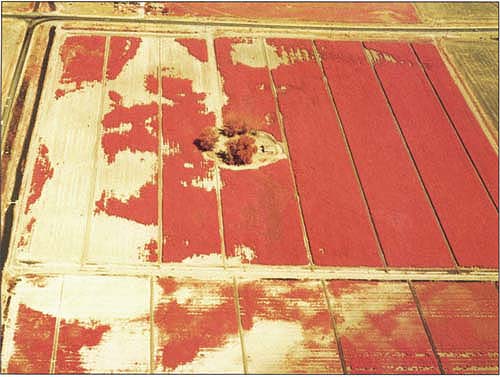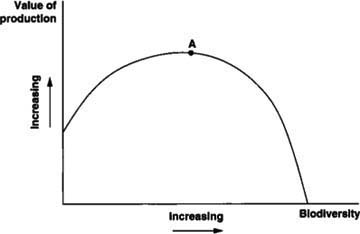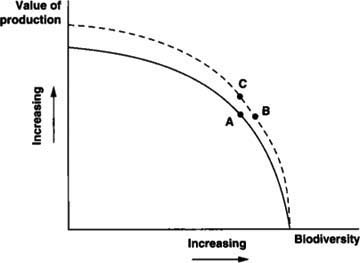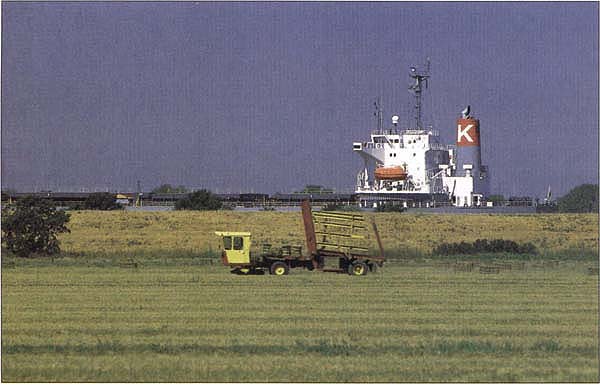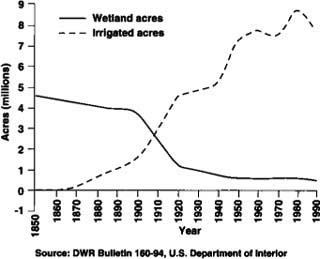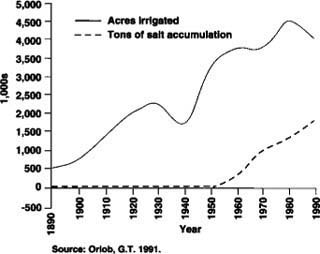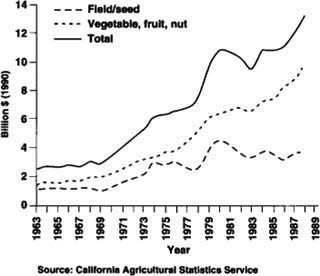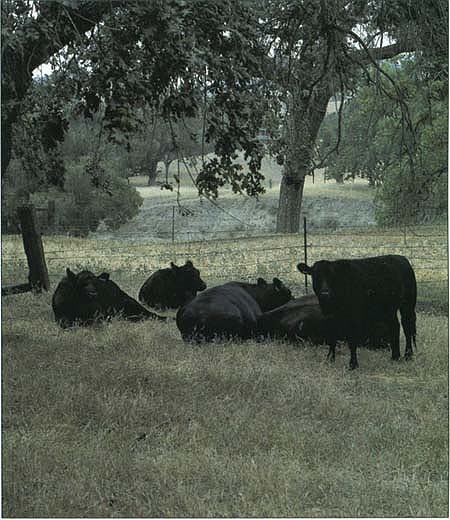All Issues
How economic incentives for growers can benefit biological diversity
Publication Information
California Agriculture 49(6):28-33. https://doi.org/10.3733/ca.v049n06p28
Published November 01, 1995
PDF | Citation | Permissions
Abstract
Reduction in biological diversity is an inevitable outcome of economic pressures and technological innovations in the initial stages of agricultural development. However, some research shows that economic incentives steer agricultural development to areas where the impact on biological diversity is minimized. As agriculture has developed in California its effect on biological diversity has increased and the value of biological diversity is increasingly recognized. The effect of several economic and technical trends on California agriculture suggest that incentives can be modified to reconcile continued profitability of the agricultural industry with sustaining the current biological diversity.
Full text
Flying over the Central Valley of California in a small aircraft, I, much like Edward O. Wilson in the Amazon rainforest, have a sense of wonder at the forces that order and organize the vast agro-ecosystem that is California agriculture. But despite the wide range of crops and habitats in the Valley, the biodiversity and stability of the current system is a far cry from the original ecosystem.
When Kit Carson rode through the Central Valley in the summer of 1829, he saw a pristine natural environment:
Here ran streams of crystal water, teeming withfish and bordered by grass and wild oats. Antelope, elk, deer, and other game were in abundance.
By examining the economic forces that brought us from the complex natural ecosystem described by Kit Carson to the patchwork of natural and agroecosystems that we have today, we can clarify the tradeoffs between biodiversity and agricultural production. Economic forces have driven development of irrigated agriculture in California. In the future, economic forces and public policy can be used to reconcile the need for a viable agriculture with the need to preserve biodiversity in the Central Valley.
Buildup of byproducts of irrigated agriculture, such as the salt shown in this infrared photo, threaten crop productivity.
While the term is widely used, “biodiversity” is hard to define and even harder to envisage as an integral part of an agro-ecosystem. Other papers in this issue define biodiversity at many levels from that of genetics to that of natural communities within an ecosystem. In this paper, however, we will consider biodiversity only at the community level.
Tradeoffs and biodiversity
The present agricultural system was created by the force of population growth, and the interaction of economic incentives and evolving technological potential. For example, the development of groundwater resources in many regions was stimulated by the joint effect of rural electrification, crop price stabilization policies and improved pump technology.
It is to these same economic and technological mechanisms that we must look to solve the biodiversity problem.
As Wilson, M.L. Weitzman and many other authors have stressed, biodiversity in natural ecosystems is the outcome of natural selection pressure tradeoffs between species. Not all species survive in natural ecosystems. This concept of trading levels of one output for another given a limited resource base is common to ecological and economic systems. The balance that evolves between cattle and deer on a given area of range is based on the same concepts as the tradeoff between producing Chevrolets and Cadillacs from a factory.
When human society changes a natural ecosystem into an agroecosystem, we replace natural selection with systematic selection pressures based on technological and economic pressures. This deliberate bias in the ecosystem towards those plant and animal species that mankind finds most favorable has the inevitable effect of reducing the biodiversity of the natural community. The difference between natural and economic ecosystems is in the way that tradeoffs are made between species. While species loss occurs in natural systems through competition, diversity levels are higher in ecosystems with natural selection due to genetic mutations and introductions from other ecosystems than in those with systematic selection (see box below).
The initial stages of agricultural development can be thought of as adding information to the ecosystem to intentionally reduce the biodiversity. Anyone who has had a small child help them weed a garden will understand that random plant removal without first adding information on which plants are weeds is not useful weeding, and does nothing to change the probability of finding plants versus weeds in the garden. In this initial stage of agricultural development, people perceive themselves to be heroically struggling against the dominant forces of nature. Growing a crop of wheat on the prairie is correctly perceived as a triumph, despite the consequent reduction in local biodiversity.
A probability measure of biodiversity
A measure of diversity within any system is the entropy of the system. High entropy levels indicate a greater degree of dispersion within the system. Thus a new planting of almond trees intercropped with barley has a higher entropy than a mature stand solely of almond trees. Shannon has shown that the entropy level is also a measure of the information level in a system, with lower entropy systems containing greater information. Imposing selection pressure that is wholly or partially driven by additional information will reduce the entropy, and hence the diversity, of natural systems subject to systematic rather Darwinian selection pressure.
However, like all predators in the ecosystem, we must recognize that forces to counterbalance our effect on the “prey” are required for our own long-term survival. This principle is especially valid for irrigated agriculture, where the long-term unintended buildup of byproducts such as salt is a major threat to agricultural productivity.
If economic forces are seen as the primary motivation in agriculture, production can be measured in terms of its economic value to human society. Figure 1 shows the tradeoff frontier between production and biodiversity when agricultural production increases as a result of additional land or water development in a given ecosystem. When no land is developed, the ecosystem has the maximum biodiversity. As land and other resources are developed for agriculture, biodiversity decreases.
The tradeoff between agricultural production and biodiversity has been analyzed by M. Huston of the Oak Ridge National Laboratory Environmental Science's Division. Huston proposes lands that are more fertile — in other words, those that are best suited for agriculture — have a lower natural biodiversity. Since the most fertile areas are cultivated first, the initial tradeoff between productivity and biodiversity is small because production is relatively high while biodiversity loss is relatively low per acre. However, as agriculture moves into the less fertile areas of our ecosystem, which have higher natural biodiversity, the tradeoff becomes greater. Further agricultural development yields small increases in productivity and large decreases in biodiversity per acre. Paradoxically, feeding urban populations in developing nations from agriculture in developed nations in the temperate zones of the world may be the least costly solution to preserving global biodiversity. While Huston's hypothesis is on a global scale and is not without criticism, the proposal is supported by other work on biodiversity.
Fig. 2. A = Point at which the capacity of the natural ecosystem to assimilate agricultural byproducts is exceeded and both biodiversity and agricultural production are reduced.
Fig. 3. A = Old farming practices. B = New farming practices. A new technology such as an improved crop variety can improve output with the same biodiversity, moving from point A to point C.
The optimal balance of production and biodiversity depends on a tradeoff between values. Of course, it's not easy to measure an economic value for biodiversity because, like displays of fireworks on the Fourth of July, biodiversity has characteristics that economists term collective or public goods. In short, while the benefits of biodiversity accrue to all members of society, the costs of conserving biodiversity are borne by the individuals who forego production value. This means that there is little incentive for these individuals to provide the benefits of biodiversity to society as a whole. Add the lack of knowledge on biodiversity levels and the slow initial rates of biodiversity loss, and it is easy to see why the market forces that so successfully stimulate agricultural production, may not encourage biodiversity preservation.
The loss of wetlands was initially driven by the need for flood control. In many areas land has subsided as much as 15 feet below sea level, chiefly due to oxidation of exposed peat soils.
Counterbalancing the loss
In the current agro-ecosystem, some political pressures have recently begun to counterbalance biodiversity loss by promoting the maintenance or increase of biodiversity. These pressures (e.g., the Endangered Species Act) are based in part on the realization of the value of future genetic diversity, the growing demand for access to environmental amenities, and the current unsustainability of some resources, such as underground water, in the present agro-ecosystem.
Given the initial assumption that we need to produce enough food and fiber to maintain our advanced standard of living, the problem that remains is to modify the incentives that have fostered our current agroecosystem until they reflect the values and requirements of stabilizing biodiversity.
Measures to conserve biodiversity may also make agriculture more sustainable. For example, in the long run, detrimental agricultural byproducts such as salt can accumulate and so reduce both productivity and biodiversity (fig. 2). A widely cited example of this phenomenon is the effect of salinity buildup, which has been the downfall of past societies — Mesopotamia, Babylon and Southwestern Pueblas among them — which were founded on irrigated agriculture. The one exception, Egypt, maintained its salt and fertility balance due to natural annual flooding which removed salt and deposited fertile silt.
One way to resolve the problem is to use technology to extend the range of economic farming practices (fig. 3). An example is getting rid of the straw from harvested rice fields by flooding (which rots the straw) rather than burning, which provides additional waterfowl habitat. While sometimes more costly, this type of technology can increase biodiversity while maintaining production levels.
Irrigation and biodiversity
Irrigated agriculture in California affects the biodiversity both of the remaining natural ecosystems and of the agro-ecosystem. However, an economic trend to more intensive production in California agriculture may provide an opportunity to moderate biodiversity loss without catastrophic losses to California's irrigated agriculture.
One of the better-known environmental statistics in California is that over 90% of the original natural wetlands in the Central Valley have been lost to irrigation development (fig. 4). A more complete statement would add that with the loss of the natural wetlands came a greater increase in irrigated acreage. Much of the wetlands loss was from flood protection and navigation projects. This shift from a natural ecosystem with a wide range of biodiversity to an agroecosystem with reduced biodiversity initially made the Central Valley habitable for the new settlers.
The loss of California wetlands was initially driven by the need for flood control and levees to improve river navigation. However, from 1900 to 1925, the correlation between wetlands loss and the expansion in irrigated acres is striking. Interestingly, the large state and federal interbasin water projects (e.g., the Central Valley Project) that stimulated the growth in irrigation from the 1960s to 1980 had little effect on the loss of wetlands. While the total productivity of secondary sources of food (crop residues) for some wildlife may have increased by this switch from wetlands to irrigated acreage, the overall effect on biodiversity was almost certainly negative.
Drainage and salinity
While drainage and salinity problems were anticipated in the initial planning stages of irrigation development (1950-1960) by academics, government agencies and farm organizations, these problems have yet to be resolved. Of a more insidious nature are the unforeseen effects both of bioaccumulation of trace elements such as selenium and heavy metals in drainage systems, and of the decline in fish populations that seems linked to water diversions at certain times.
The well-documented salt accumulation and waterlogging of irrigated land in the San Joaquin Valley has caused a reduction in biodiversity. The effect of bioaccumulation of selenium and heavy metals on wildlife was brought into stark relief with the discovery of deformed mud hens at the Kesterson National Wildlife Refuge in 1983. This reduction of biodiversity within the agro-ecosystem may be attributed to government policies which dominated market incentives. Without the government subsidies that enabled the construction of large-scale water projects, it is most unlikely that we would have developed some of the irrigated areas in the Central Valley that generate environmental problems.
For the first 50 years of irrigation development, excess salt was not a problem in the San Joaquin Valley mainly because the irrigation water was not imported into the basin. However, since the growth in irrigated acreage and the advent of imported water in the 1960s, the salt accumulation has gotten progressively out of balance (fig. 5). Unless the current salt imbalance is redressed in the future, the increase in areas with shallow saline water will significantly and permanently reduce both the biodiversity and agricultural productivity of the San Joaquin Valley.
With the current restrictions on the originally planned drainage outlets through the Bay and Delta, the ability to remove the byproducts of irrigation from the basin is severely compromised. Unfortunately there is a very real human cost to not building drainage outlets since people have made substantial investments assuming that there would be a technical solution to the drainage problem, allowing federal water supplies to continue in the long term.
A report from an interagency task force concluded that drainage problems in the central San Joaquin Valley can be resolved, but only by a combination of changes in crop pattern, irrigation technology, land retirement and drainage treatment. However, any such changes must be achieved at minimum social cost.
Technological and market shifts
There is a way for California agriculture to grow more profitable, to increase economic output (benefiting the community with jobs) and at the same time reduce land and water inputs. The solution incorporates both technological and market improvements. The technological improvements must enhance the productivity of the resources, while the market shifts should allow California farmers to sell more high-value crops such as fruits and vegetables. This market growth will enable farmers to increase the average value and profitability of crops grown on the existing, or probably reduced, resource base.
A large part of the solution depends on the continued growth of the market for California fruits, nuts and vegetables. The prospects for continued growth are good, both because diets in the developed world are shifting toward fresh fruits and vegetables and because income in the Pacific region is increasing. The Central Valley is one of the few agricultural regions where the market for its products grows with consumer income.
Due to technological and marketing advances, over the past decade California agriculture has been able to expand in terms of total value of output while using fewer biological resources. From 1980 to 1990, irrigated acreage fell by 11% while the total value of production increased by 34% (figures 4 and 6). The breakdown of revenues between field and high value crops shows that over the past 15 years the gross revenues of fruits, nuts and vegetables has increased from one-half to two-thirds of the total value of production.
If the growth rate in agricultural production value can be continued (and it is more likely than not), agricultural land area and water use can be gradually reduced by economic incentives without reducing profits or revenues from the agricultural sector. The shift to more valuable crops has the serendipitous effect of decreasing water use per unit land for two reasons. First, high-value crops generally use less water per acre (California Dept. of Water Resources Bulletin 113-4) and second, the capital investment required for more efficient methods of irrigating can be justified when growing higher value crops.
Unfortunately this shift to higher value crops takes place under intense market pressure from other counties and regions and cannot be hurried. For example, Chilean fruits and vegetables can be delivered by jet. The urgent biological and political pressures for biodiversity and environmental reform has and will continue to cause short-run hardship for some parts of California's agricultural industry before the long-run market adjustments compensate for the restrictions on the type and time of use of land and water. The degree of hardship depends on the industry's ability to readjust its resource allocation given the current uncertainties and reductions in resource availability.
Policies and economic incentives
Given that the challenge for the future is to manage the agro-ecosystem to maximize the biodiversity within the system and eliminate harmful effects on associated natural ecosystems, what is the role of economics? Ecologists have long regarded economic pressures with deep suspicion, since they correctly perceive that ill-defined economic pressures are one reason for suboptimal resource use. However, economic incentives that include the full cost of agricultural production will allocate it to the more fertile areas. Given Huston's hypothesis that the most fertile lands (that is, those best suited to agriculture) have less biodiversity, it follows that true economic allocation of production will have less impact on biodiversity.
The central policy question is: Can the resource use by irrigated agriculture be downsized without a major downsizing of the industry? I think the answer is yes and it can be achieved using the following policies.
Market growth.
The growth of markets for California's fruit, nut and vegetable crops can provide relief for the irrigated crop industry. However, since there are no policies that can hasten changes in market tastes and the number of people buying produce, those who set standards for biodiversity must make allowances for these adjustments. For example, it may be that the cost of biodiversity improvement to the agricultural industry depends more on the speed and predictability of changes in the resource base, rather than the absolute degree of change. Given the technology and capital involved, rapid changes are more expensive than gradual, wellplanned changes. Those pushing for agriculture to use fewer resources must consider the advantages of smaller, rapid changes versus greater, longer-term changes.
Reallocation.
While reallocation of resource use and crop production is essential, we should resist the impulse to let planners dictate crops or regions of production. It is hard to find a successful example of centrally planned agricultural production, but easy to identify many economic and environmental debacles caused by central planning (e.g., in the former Soviet Union). A practical approach is to have economic incentives that use the farmer's knowledge to minimize the impact on the industry. In other words, let the farmers decide how to implement the adjustments, not the level of biodiversity. Efficient reallocation can be achieved by allowing farmers to trade water and by mitigating habitat requirements by replacing habitat from one area with an equivalent type elsewhere.
One of the most notable examples of regulating the effects of the agroecosystem on natural biodiversity is the recently passed Central Valley Project Improvement Act, which mandates that development interests return at least 800,000 of the average annual 7.8 million acre-feet of federally developed water to instream environmental uses, leaving the water in the river for its environmental value. If the original regulations against trading federally developed water remain, the few water districts in the San Joaquin Valley that have the lowest priority rights for federal water will bear the brunt of the water reductions. Many of these regions grow large areas of highvalue crops, generating more value with the water.
The social cost of this water reallocation has the potential to be greatly reduced by changing economic incentives and institutions. For example, studies show that when agricultural regions are allowed to trade water freely, the cost of this substantial water reduction can be halved. Under a water market system, those crops and regions that can voluntarily reduce their water use at the lowest cost will do so.
Technical change.
Technologies that reduce the effects of irrigated agriculture on biodiversity are already available. One of the most common types uses more efficient irrigation techniques. Therefore, rather than new technologies, farmers need financial incentives to adopt those that are currently known. These incentives can take the form of a push from increased water costs or taxes, or a pull from increased values of the resources to the decision maker. There have been recent significant increases in the cost of water to some irrigators. However, the regions with the most water and thus the most potential to reduce water use, are insulated from cost increases due to long-term contracts or rights established at the turn of the century, which can last 40 years or longer. Establishing markets where it is easy and secure for irrigators to sell water will provide an incentive for the adoption of more efficient, but expensive, resource management methods.
Joint production.
The joint production of crops and wildlife habitat can help to stem current reductions in biodiversity and provide mitigating habitat for certain species. While this habitat will not recreate the original ecosystem, biodiversity will be increased at the species and genetic level. Irrigated agriculture has some beneficial effects on wildlife including supporting very large populations of duck, geese and other birds. Some notable examples are seen in the Grasslands irrigation district in the San Joaquin Valley, which uses its own water entitlement and water flows returned from surrounding irrigation districts to support extensive wetlands habitat adjoining agricultural lands.
Examples of agricultural activity increasing the biodiversity of the agro-ecosystem are also seen in the livestock grazing sector. While overgrazing rangeland leads to biodiversity loss, undergrazing also reduces biodiversity on some types of range. A widely researched example is the oak range savannah found in the foothills around the Central Valley. In the absence of grazing, the climax (natural end-product) oak vegetation would have much more canopy, and be less desirable from both an aesthetic view and wildlife production by shading other kinds of plants, keeping them from growing.
Industry growth vs. biodiversity
The loss of biodiversity in California over the past 150 years of agricultural development is an inevitable outcome of the resource development stage of irrigated agriculture. However, California is now at a point where further reductions in the biodiversity may be very costly in social and economic terms. Fortunately, by intensifying the development and use of technology that uses resources more efficiently, California's irrigated agricultural industry will be able to grow in economic and production terms while using fewer natural resources and minimizing current losses in biodiversity.
While the intrusion of the agricultural and urban ecosystems on the remaining natural ecosystems needs to be controlled by regulations, economic concepts also have a role in managing biodiversity. There are four main roles for economics in biodiversity management: (1) assessing the implicit costs of alternative regulations on agriculture; (2) minimizing the cost of implementing the regulations; (3) measuring the long-run benefits to society of maintaining a given biodiversity level within the agro-ecosystem; and (4) calculating the costs or benefits of delaying policies that encourage increased biodiversity. Compared to the current system of species-based regulation, using economic incentives or penalties to reflect the value of increased biodiversity is closer to natural selection pressures because this method also is based on tradeoffs among species.
Agricultural activity can lead to increased biodiversity. The oak range savannah shown above actually benefits from the presence of grazing animals which enhance the habitat under the trees for increased plant growth and wildlife habitat.
Given the record of the past 15 years and the market growth prospects for many of California's agricultural products, the ability of irrigated crop production to simultaneously adjust to demands for increased biodiversity and production is costly but not impossible. However this adjustment will depend on two types of information. The most important type is that embodied in the production and marketing knowledge of decision makers in the industry. The most effective way to motivate the application of this management information is to change the perception and economic value of conserving biodiversity. The second requirement is for supply of resource-enhancing technology from the private and public research sectors.



